Prospecting Strategies
Published on December 14, 2023 by Sawyer Middeleer
Effective prospecting is the lifeblood of any B2B sales operation, crucial for maintaining a healthy pipeline and achieving growth targets. With the competitive business landscape constantly evolving and buyer behaviors shifting, it's imperative that sales teams continuously refine their prospecting strategies to connect with potential clients. By deploying a mix of innovative tactics alongside proven methodologies, representatives can ensure their outreach is impactful and their sales funnels robust.
Here are strategies and best practices to enhance your prospecting prowess and boost your team's success rates.
Understanding Modern Prospecting
Prospecting in today's market is not solely about finding new customers; it's also about understanding those potential customers so deeply that your outreach feels personal and timely. A vital component is leveraging data to inform your engagement strategies, tailoring communications, and providing value from the first touchpoint.
1. Define Your Ideal Customer Profile (ICP)
Before engaging in any prospecting activities, you must clearly understand who you're targeting. An ICP goes beyond basic firmographics; it involves understanding your potential customers' pain points, desired outcomes, and behavioral triggers. This involves a deep dive into data, leveraging analytics tools to synthesize information that will guide your prospecting efforts.
2. Embrace Social Selling
Utilizing social media platforms, especially LinkedIn, where B2B buyers spend considerable time, has become non-negotiable. Still, simply showing up isn't enough. Sales reps need to provide thought leadership through consistent posting, commenting on industry trends, and engaging with potential clients' content to build rapport before an official sales call. A strategic social presence helps you stay top of mind and builds credibility.
3. Leverage Account-Based Marketing (ABM)
In ABM, you treat each targeted account as a market in its own right. It requires collaboration between sales and marketing teams to create a highly personalized buying experience for prospects. This approach demands meticulous research and content creation tailored to the pain points and aspirations of each account's decision-makers.
4. Utilize Tools to Gather Actionable Insights
Data-driven prospecting is elevated by tools like Linkedin Sales Navigator, which focuses on finding the right people and insights to build relationships. Aomni also offers AI-driven platforms that collate real-time account research to gather a wealth of insights, effectively cutting down the time sales reps spend on research.
5. Embrace Multi-channel Outreach
Relying solely on cold calls or emails is a prospecting strategy of the past. In a world where buyers are inundated with content and offers, a multi-channel approach can amplify your message. Combining emails, social media, phone calls, video messages, and even direct mail can help you stand out and reach prospects where they are most comfortable engaging.
6. Craft Compelling Content
Content can serve as a bridge between prospects and sales reps. By creating and sharing valuable content, you can educate your audience, establish trust, and draw potential clients towards your solution. Understanding your audience's pain points and the solutions they are looking for can inform your content strategy, whether it’s whitepapers, case studies, blogs, or industry reports.
7. Educate Rather Than Sell
Modern buyers prefer to learn and explore solutions at their own pace before speaking to a sales rep. Use your initial interactions to educate prospects about how they can solve their challenges or make their lives easier. Teaching, rather than selling, builds trust and positions you as a consultant, or even a partner, rather than just another vendor.
8. Prioritize Referrals and Networking
Referrals are prospecting gold. They often come with a higher level of trust and a faster sales process. Encourage happy customers to refer you to their peers, and invest in networking events and associations where your ICP might spend their time.
9. Host and Participate in Events
Webinars, roundtables, and seminars provide opportunities to demonstrate expertise and interact with prospects in a more relaxed setting. Virtual events have also skyrocketed, offering access to a broader audience. Sales reps should position themselves as resources during these events, giving prospects clear and immediate value.
10. Follow Up Strategically
Some of the most promising prospects can slip through the cracks without a diligent follow-up strategy. Automate reminders and use CRM systems to ensure prospects are nurtured through personalized follow-ups, soft touches that provide value, and re-engagement methods if they go silent.
Conclusion
Sales prospecting is no longer about casting a wide net and hoping for the best. It's about intelligence, strategy, and personalization, powered by technology and insights that enable you to reach the right people with the right message at the right time. By playing the long game, focusing on teaching and establishing trust, and using modern tools to arm your sales force with actionable insights, you're setting the stage for a successful, sustainable sales pipeline.
Remember that while prospecting is a numbers game to a degree, it's also a quality game where a single high-value prospect converted into a long-term client can make all the difference. Informed, strategic prospecting is the path to making those quality connections, setting your sales team up for outsized success.